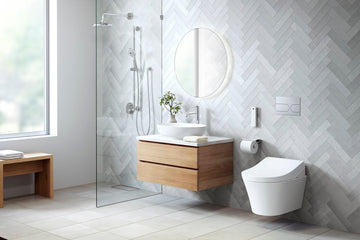In the world of smart home technology, the motion sensor toilet seat is a true game-changer. As more households and industries embrace the convenience and hygiene benefits of this innovation, it's essential to delve into what makes this technology so pivotal. At the heart of this advancement is the seamless integration of motion sensors into bathroom fixtures, providing an unparalleled user experience.
The incorporation of motion sensors into toilet seats addresses a myriad of concerns, from hygiene to ease of use. Let's explore the various facets of this innovative technology, its benefits, and its potential impact on both domestic and commercial settings.

Understanding Motion Sensor Technology
Motion sensor technology is not new, but its application in toilets is relatively recent. This technology utilizes sensors that detect movement, triggering specific actions such as raising or lowering the toilet seat without physical contact. This innovation is particularly beneficial in public restrooms, where hygiene is a top priority.
For those interested in the technical side, motion sensors typically use infrared technology, which is sensitive to heat and movement. This ensures that the toilet seat reacts promptly to human presence, enhancing user experience and maintaining cleanliness.
Benefits of a Motion Sensor Toilet Seat
Enhanced Hygiene
The most significant advantage of a motion sensor toilet seat is the hygiene factor. By eliminating the need for physical contact, the risk of spreading germs and bacteria is significantly reduced. This makes it an ideal solution for hospitals and other healthcare facilities, where cleanliness is paramount. For more on how these innovations benefit healthcare facilities, check out Toilet Innovations for Hospitals.
Convenience and Accessibility
Another notable benefit is convenience. For individuals with mobility issues or disabilities, a motion sensor toilet seat offers greater accessibility. The automatic lifting and lowering of the seat make it easier for users to operate the toilet independently, enhancing their quality of life.
Furthermore, motion sensor technology can be integrated with other smart home systems, allowing for a fully automated bathroom experience. This is particularly appealing for tech enthusiasts looking to create a cohesive smart home ecosystem.
Water and Energy Efficiency
Modern toilets equipped with motion sensors are also designed to be water and energy-efficient. By incorporating features such as timed flushing and low-energy lighting, these toilets contribute to a more sustainable household. To learn more about water-efficient toilet innovations, visit Innovations in Water-Efficient Toilets.
Challenges and Considerations
While the benefits are clear, there are challenges and considerations to keep in mind. The initial cost of installing a motion sensor toilet seat can be higher than traditional models. However, the long-term savings on water and energy, along with the enhanced hygiene and convenience, often justify this investment.
It's also crucial to consider the maintenance of these systems. Regular cleaning and occasional sensor recalibration may be necessary to ensure optimal performance. For those interested in learning more about maintaining innovative toilet systems, explore Best Innovative Toilets.
Future of Motion Sensor Toilet Seats
The future of motion sensor toilet seats is promising, with ongoing advancements in technology likely to introduce even more features. From self-cleaning capabilities to personalized settings, the evolution of this technology will continue to transform bathroom experiences worldwide.
Moreover, as the demand for smart home technologies grows, the integration of motion sensor toilet seats with other devices will become more seamless. This interconnectedness will enhance the overall efficiency and functionality of smart homes.
For a glimpse into the innovative future of toilets, consider reading The Rise of the High-Tech Toilet.

FAQs About Motion Sensor Toilet Seats
Are motion sensor toilet seats prone to malfunction?
While any electronic device can experience issues, motion sensor toilet seats are generally reliable. Regular maintenance and proper installation can minimize the risk of malfunctions.
Can I install a motion sensor toilet seat myself?
Installation can vary depending on the model. Some units are designed for easy DIY installation, while others may require professional assistance. Always refer to the manufacturer's instructions.
How do I clean a motion sensor toilet seat?
Cleaning a motion sensor toilet seat is similar to cleaning a regular toilet seat. Use non-abrasive cleaners and avoid harsh chemicals that could damage the sensors. Regular cleaning will help maintain its functionality.
This article contains affiliate links. We may earn a commission at no extra cost to you.






